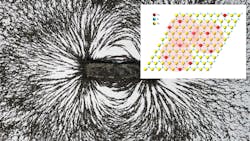Attractive Properties
Researchers at the Dept. of Energy’s Lawrence Berkeley National Laboratory and UC Berkeley have developed a one-atom-thick magnet that operates at room temperature. It could lead to new applications in computing and electronics such as high-density, compact spintronic memories and new tools for studying quantum physics.
As Machine Design reports today, the team fabricated the new magnet, called a cobalt-doped van der Waals zinc-oxide magnet, from a solution of graphene oxide, zinc and cobalt. The mixture was baked for a few hours in an oven, which turned the mixture into a single atomic layer of zinc-oxide with some cobalt atoms sandwiched between layers of graphene. The goal is to develop thinner and smaller magnets that will store data at much higher densities.
Pulling Lithium from Water
Another big use for magnets, as Machine Design also reported, is the opportunity to separate lithium from subsurface water pumped for oil and gas extraction. Just a quarter of the lithium in that water would equal the current annual worldwide production, according to scientists at the Pacific Northwest National Laboratory (PNNL).
“Current approaches for extracting lithium, however, require pumping large volumes of water, thousands of gallons a minute, through an ion exchange filter, making them energy intensive and expensive,” said Pete McGrail, a PNNL researcher and recognized expert on rare earth metal recovery technology.
“By using the magnetic nanoparticles to attach to the lithium particles in solution, we expect the resulting lithium to be purer, thereby reducing the cost of further processing,” said Jerry Mills, CEO of Moselle Technologies, a start-up business that is piloting the technology in several global locations and has exclusive licensing on it. “And this will take out more than half the cost of lithium.”
About the Author

Bob Vavra
Editor Emeritus, Machine Design and Power & Motion
Bob Vavra is the former senior content director of Machine Design and Power & Motion.
